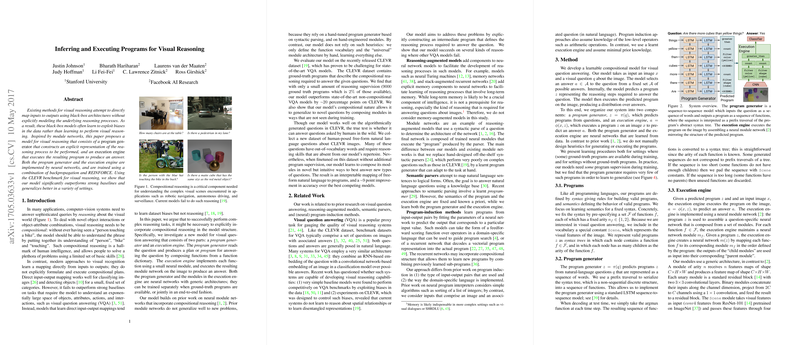Inferring and Executing Programs for Visual Reasoning
The paper "Inferring and Executing Programs for Visual Reasoning" addresses a critical challenge in computer vision: the need for systems capable of sophisticated visual reasoning, akin to human-like compositional thinking. Traditional models map inputs directly to outputs, often failing in tasks requiring nuanced understanding and reasoning about object attributes and interactions. This work proposes a novel model that explicitly constructs and executes reasoning steps, thereby shifting away from reliance on black-box architectures prone to exploiting dataset biases.
The proposed model integrates two main components: a program generator and an execution engine. The program generator reads the input question and constructs a structured sequence of reasoning steps. This sequence is executed by the execution engine, which employs neural modules designed to perform specific sub-tasks. Unlike previous module networks that rely on hand-crafted parsing and modules, this model requires minimal prior engineering, primarily defining a universal module architecture and learning semantics through training.
Evaluated on the CLEVR dataset—a benchmark known for its challenging, bias-controlled synthetic questions—the model demonstrates impressive performance. A key result is a 20-point accuracy improvement over state-of-the-art non-compositional VQA models, highlighting the strength of the compositional approach. Moreover, the model can generalize to novel questions, showcasing a capacity to handle scenarios it hasn't encountered during training.
A significant advantage of the model is its sample efficiency. It achieves high performance with as little as 9,000 ground-truth programs from the available 700,000, indicating the model's ability to generalize effectively from limited data. The capacity to adapt and learn new linguistic constructs through fine-tuning on human-generated free-form questions further attests to its flexibility and robustness.
Implications and Future Directions
The implications of this research are noteworthy in several domains requiring robust reasoning capabilities, such as autonomous systems, robotics, and security applications. From a theoretical standpoint, this approach challenges current paradigms in visual recognition by emphasizing compositionality and explicit reasoning.
Further exploration could focus on expanding the model's linguistic diversity and reasoning capability to encompass more complex scenarios and datasets. Future developments could also explore the integration of memory components to address tasks requiring long-term reasoning or dialogue systems. Enhancing the execution engine with adaptive module learning could further improve its generalization to unseen visual reasoning tasks.
This work contributes a significant step toward closing the gap between human-like reasoning and machine vision, presenting a promising direction for future AI research in complex decision-making and understanding contexts.
